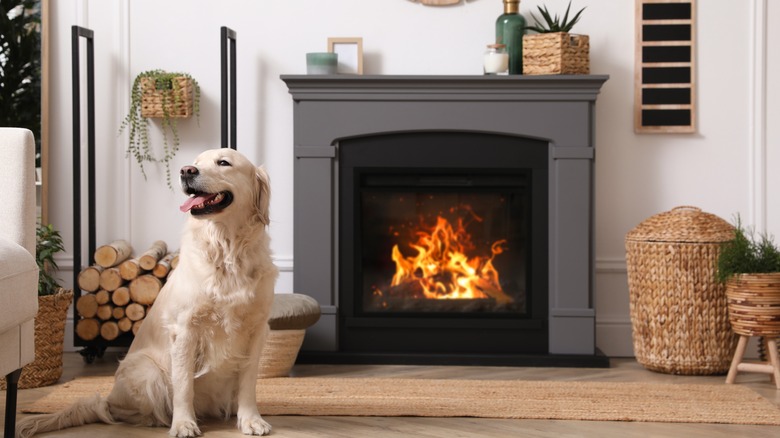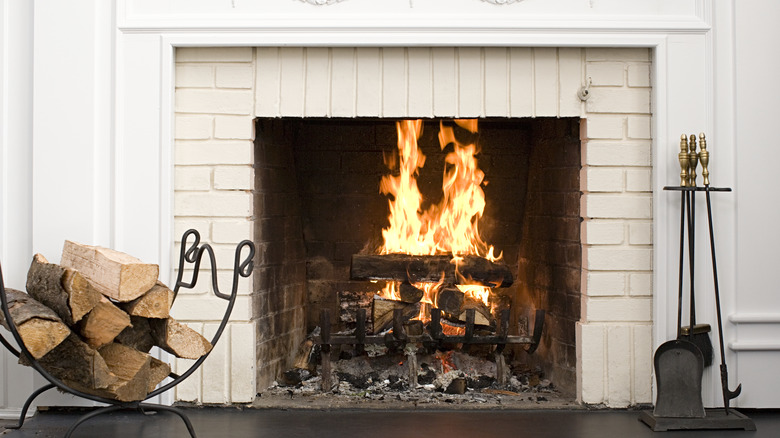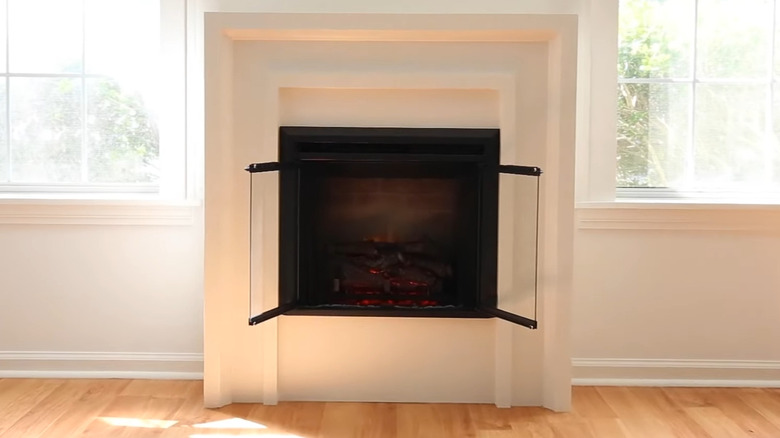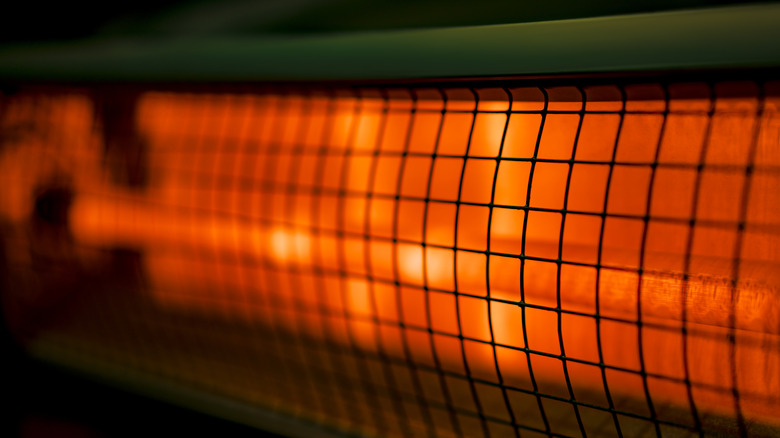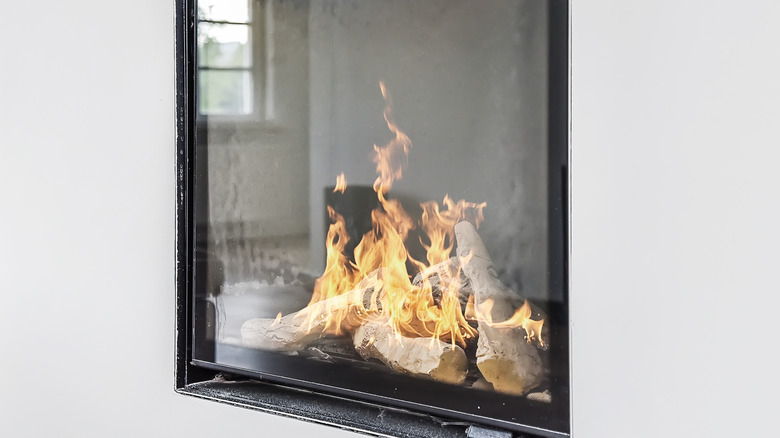The Hidden Downsides To Fake Fireplaces
The crackling sound of the roaring fire, the mantelpiece that houses some of your favorite portraits — these are some of the reasons why the fireplace has become a classic home stape. And with the winter nip now in the air, the desire to recreate that warm, cottage-like feeling is at an all-time high. Although this one-time staple of every home is no longer the focal point in modern architecture, it is difficult to deny the beauty and romance this component adds to your abode. Thankfully, if you don't already have one installed, there are different types of fireplaces to fit your budget and aesthetic.
For many who long for that vintage aesthetic, the faux fireplace has become an increasingly viable alternative. But what exactly is a fake fireplace? More often referred to as an electric fireplace, this modern-day alternative is effectively a space heater that mimics the aesthetic of a natural gas or wood fireplace, as per Burning Log. In many ways, the electric fireplace has advantages. For one, you can recreate a fireplace in any home without needing a chimney. However, as with any home component, there are some downsides to getting a fake fireplace.
They may not provide as much heat
It goes without saying that beyond the beauty of the classic fireplace, its heating prowess is its main calling card. The ability to be warmed up by a wood or gas fire means the space will be as toasty as you require. However, despite its luxurious look, the electric fireplace is no more than a glorified space heater, so its heating capabilities are unfortunately limited. It isn't always straightforward to tell how ample a space this faux fireplace can warm up, but as with many other portable heaters, it can heat an area of up to 1,000 square feet or less. This is ideal for people with smaller spaces, but if you've got a big ol' space, this can be a bit of a challenge.
According to Fireplace Universe, your electric fireplaces capabilities will come down to if it uses a fan or infrared to heat. With the former, you can heat a space no more than 400 square feet, but with an infrared-powered heater, you're looking at about 1,000 square feet, as previously mentioned. Any bigger, though, and you run into an issue.
They can be expensive in the long run
Despite the initial cost being relatively inexpensive, the running cost could affect your energy bill negatively. According to research conducted by Eco Cost Savings, electric fireplaces aren't the kindest to your energy bills. The study found that using an electric fireplace can add almost 30% to your existing energy bill, which is a lot. The study did emphasize that the electric fireplaces more likely to guzzle energy are those with an output of 1,500W. While there are different levels to production, if you have purchased an electric heater, the likelihood is that you're looking to heat a relatively larger space.
Compared to other home appliances, the study found that using an electric fireplace for an hour equals the running of a refrigerator over the course of one day or how much energy a ceiling fan uses over two days.
Nothing beats the real thing
When we think of a fireplace, we think of a feeling — a moment when all seemed calm, quiet, and still. The crackling of the wood as the roar of the fire gently lulls us into a state of ease. It's a whole thing. And unfortunately, with an electric fireplace, you don't get that. Sure, you might be able to create a simulation of it by playing an hours-long YouTube video of a roaring fire while watching your electric fireplace light up, but ain't nothing like the real thing, baby.
With an electric fireplace, you miss out on the atmosphere that a real fireplace provides, even when it's not lit. According to Magik Flame, manufacturers aren't as interested in creating an electric fireplace with a similar aesthetic to the real thing. Instead, they're more concerned with simply making a heater. This leads us to the next disadvantage.
They're aesthetically limited
Compared to the classic fireplaces we've known and loved for centuries, these new modern takes aren't nearly as grand or even as beautiful as the ones of yore. Regrettably, because the main goal of the electric fireplace is to heat up rooms of up to 1,000 square feet (depending on which type you get), little emphasis has been placed on creating an aesthetically diverse range of options for potential consumers to choose from.
Unless one attempts to make a functional faux fireplace themselves — and there are ways to do it, like this how-to video courtesy of Angela Marie Made on YouTube — you will find yourself stuck with the same modern design. A way to avoid this is to take your time to shop the available options. This also means spending quite a bit more since you need to go for the higher-quality models that offer a slightly more realistic version.
Real fireplaces can add value to your home
Of course, this depends entirely on where you are located. With many housing markets seeing a decline in traditional fireplace fixtures, other environs are more inclined to tick "yes" when asked if a property needs a fireplace to be of interest to them as potential buyers. Residential appraiser Rachel Massey told HomeLight, "For a market of winter mountain lodges, I would expect there to be a resounding 'yes' in terms of it mattering, and the large stone fireplaces with rough-sawn timber mantels may be all the rage."
In fact, it is believed that in particular "luxury" areas of the United States, a fireplace is seen as an expected amenity in certain homes. On the opposite end of the spectrum, the National Association of Home Builders found that only 41% of single-family homes included fireplaces, which is a drop from 57% in 2001 (via NAHB).
There are some safety concerns
Though not many, there are a few safety concerns with a faux/electric fireplace. One thing to note with electric heaters is, though they don't produce real flames, models on the cheaper end of the price spectrum can be susceptible to overheating. Since it is essentially a space heater, the electric fireplace often has many of the same issues as its less flamboyant cousins.
The National Fire Protection Association (NFPA) suggests keeping your space heaters about three feet away from anything combustible, such as beds, sofas, curtains, and the like. Another thing to note is when to turn it off. While space heaters can work for prolonged periods of time, it is often advised to shut them off for a few hours so they can cool, especially when there are vulnerable people close by. All in all, the electric fireplace is believed to be a safer model than a traditional fireplace because it doesn't produce real flames. However, there are still many things one must note to remain safe and unharmed.
They only work with electricity
While a traditional fireplace needs only wood or coal to get it to work, the modern deconstruction known as the electric fireplace uses only electricity. This means you're limited to where to place it in your space and how it can be used.
Unfortunately, it also means that you must have the power to heat your space, which can sometimes — though rarely — be a cause for concern. For example, during infrequent but possible blackouts, an electric fireplace is rendered useless to homeowners as they try to figure out how best to stay warm in such moments. It is advisable to have a gas, coal, or wood heating option as a backup plan. This is mainly because an electric fireplace, limited in how much warmth it can provide in ample space, isn't the ideal option as your space's primary source of heat, as per We Love Fire.
They can impact your carbon footprint negatively
Electric fireplaces can negatively contribute to your carbon footprint depending on how often you use them and how often it stays plugged in. In 2022, the University of Virginia's Office for Sustainability launched a "Break Up with your Space Heater campaign." The campaign encouraged faculty members and students to exchange their energy-guzzling space heaters for more sustainable options. The campaign shed light on exactly how much a space heater — and, in essence, an electric fireplace — could contribute to increasing one's carbon footprint.
One of the critical things to consider is having control of your heat output (via Which?). If you are trying to heat a smaller room, you would want to have control over the settings of your electric fireplace to ensure you're not blasting at maximum wattage when a lower setting will suffice. It's all about balance and being aware of your power usage.
They need to be cleaned regularly
Though many often eschew the cleaning demands of an electric fireplace, it is vital to keep it clean and free of dust and clutter to keep it running optimally. This can be a bit of an inconvenience for those who wish to set it up and never think about it again. Vertical Chimney Care suggests wiping the glass cover of an electric fireplace weekly, particularly if you have young people and pets in the space. Handprints, paw prints, mouth prints, and all may create a streak that will increasingly become unsightly if not correctly cleaned regularly.
There's also the small matter of maintaining the fan of your electric fireplace to ensure it continues to work effectively. To remove any obstructions, such as dust, ensure the heater is cool to the touch, and remove any coverings. Wipe down the blades with a damp microfiber cloth and place them back correctly.
